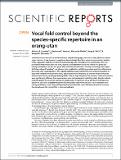Vocal fold control beyond the species-specific repertoire in an orang-utan
Date
27/07/2016Metadata
Show full item recordAbstract
Vocal fold control was critical to the evolution of spoken language, much as it today allows us to learn vowel systems. It has, however, never been demonstrated directly in a non-human primate, leading to the suggestion that it evolved in the human lineage after divergence from great apes. Here, we provide the first evidence for real-time, dynamic and interactive vocal fold control in a great ape during an imitation "do-as-I-do" game with a human demonstrator. Notably, the orang-utan subject skilfully produced "wookies"-an idiosyncratic vocalization exhibiting a unique spectral profile among the orang-utan vocal repertoire. The subject instantaneously matched human-produced wookies as they were randomly modulated in pitch, adjusting his voice frequency up or down when the human demonstrator did so, readily generating distinct low vs. high frequency sub-variants. These sub-variants were significantly different from spontaneous ones (not produced in matching trials). Results indicate a latent capacity for vocal fold exercise in a great ape (i) in real-time, (ii) up and down the frequency spectrum, (iii) across a register range beyond the species-repertoire and, (iv) in a co-operative turntaking social setup. Such ancestral capacity likely provided the neuro-behavioural basis of the more fine-tuned vocal fold control that is a human hallmark.
Citation
Lameira , A R , Hardus , M E , Mielke , A , Wich , S A & Shumaker , R W 2016 , ' Vocal fold control beyond the species-specific repertoire in an orang-utan ' , Scientific Reports , vol. 6 , 30315 . https://doi.org/10.1038/srep30315
Publication
Scientific Reports
Status
Peer reviewed
ISSN
2045-2322Type
Journal article
Description
ARL was supported by a European Union COFUND/Durham Junior Research Fellowship.Collections
Items in the St Andrews Research Repository are protected by copyright, with all rights reserved, unless otherwise indicated.

